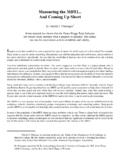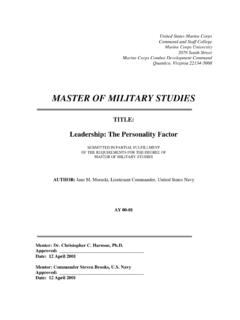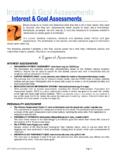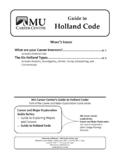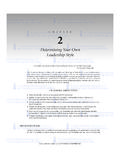Transcription of Communication Success with Four Personality Types
1 Communication Success with four Personality Types Second Edition Preston Ni, Professor of Communication Studies 2 Also by Preston C. Ni How to Communicate Effectively and Handle Difficult People, 2nd Edition Ten Tips to Presentation Confidence and Reducing Nervousness Bridging Cultural Communication Differences: East and West Cross-Cultural Communication : East and West (DVD/Video) with Dignity and Honor Understanding Racism, Unlearning Racism, 2nd Edition For more information or to purchase, visit Prof. Ni is available as a presenter, workshop instructor, course designer, and personal coach.
2 For more information, write to or visit Copyright 2007 Preston C. Ni. All rights reserved worldwide. No part of this manual/article shall be reproduced in any form whatsoever, stored in a retrieval system, broadcasted, transmitted, or translated into any kind of language, in any form or by any means, electronic, mechanical, photocopying, recording, or otherwise, without the express prior written permission from the author. No responsibility for the loss occasioned to any person acting or refraining from action as a result of the material in this publication can be accepted by the author or publisher.
3 No patent liability is assumed with respect to the use of the information contained herein. The author and publisher assume no responsibility for errors or omissions. Neither is any liability assumed for damages resulting from the use of information contained herein. 3 Contents Introduction 4 The four Personality Types 5 Relater-Supporters 6 Communication Success with Relater-Supporters Initiator-Cheerleaders 8 Communication Success with Initiator-Cheerleaders Analyzer-Investigators 10 Communication Success with Analyzer-Investigators Driver-Leaders 12 Communication Success with Driver-Leaders References 16 4 Introduction What is human behavior?
4 In what ways are we similar and different? How can we successfully communicate with one another? This article, in part, is an interpretation of the well known myers - briggs Type indicator . This and similar tests are now used by many organizations in hiring, professional development, and performance evaluation. The tests are available on the web as well as in print (see references). The purpose of this article is to present an overview of four major Personality Types , identify their strengths and challenges, and provide information on how to communicate more effectively with each type as family, friends, colleagues, and customers.
5 Please keep these two cautions in mind as you read this article: First, this information is for reference only. There s always a risk with Personality tests of sorting people into boxes. Even when a person clearly matches one Personality type, not everything written about that type may match the person. We re far too complicated to fit neatly into broad categories. Second, most of us have a dominant Personality type, with one or two secondary Types . These traits can change and evolve over time. As Buddha once said, A finger pointing at the moon is not the moon itself. An intelligent person makes use of the finger to see the moon.
6 There are many ways to help achieve greater human understanding and Communication Success . The information presented in this article may point to one. 5 The four Personality Types The four Personality Types are: Relater-Supporter, Initiator-Cheerleader, Analyzer-Investigator, and Driver-Leader. It s generally not too difficult to identify the primary Personality type of an individual, based on his or her persona, Communication style, and to some extent profession. Here are some of the most dominant traits of each type: Relater-Supporters tend to be nice , supportive, nurturing, and friendly.
7 Initiator-Cheerleaders tend to be energetic, motivating, persuasive, and fun. Analyzer-Investigators tend to be detail oriented, task driven, analytical, and matter-of- fact. Driver-Leaders tend to be powerful, achievement conscious, control oriented, and productive. While the dominant Personality type of most individuals tends to be fairly easy to observe, the secondary Personality type (or Types ) tends to take some knowing of a person to deduce. Most people have one dominant, one or two secondary, and one weakest type. The following pages describe each Personality type in detail, including strengths and challenges, relationships with other Types , and Communication strategies with each type as family, friends, co-workers, and customers.
8 6 Relater-Supporters Common Professions: People-oriented and service professions, such as nursing, counseling, executive assistant, and customer service. Traits Nurturer, sociable, value interpersonal relationships and are more subjective in decision making. Their conduct is often based on values and intuition. They are emotion oriented, persuasive, take care of others and are romantic introverts. Challenges Personal feelings can get in the way of objectivity. They can be too passive, can t say No and are conflict avoidant. They take care of the self last and make sacrifices for others at the expense of the self.
9 Relationship with Other Types Initiator positive: Admire Initiators, want their energy to rub-off and want to be part of the fun. Initiator negative: Overwhelmed by the high energy of the Initiator. Analyzer positive: Glad capable Analyzer can handle details of the task. Analyzer negative: Think of the Analyzer as cerebral, cold, impersonal and lacking human sensitivity and consideration. Driver positive: Feel supported by the people person Driver. Driver negative: Find the Driver intimidating and domineering. Core Needs: Relater-Supporters want to be liked, accepted, and loved.
10 Validating Core Needs: As genuine and appropriate, remind Relater-Supporters on a regular basis how much you appreciate who they are, what they do, and the quality of the relationship. In Summary: For a Relater-Supporter, a day without a smile, kind words, and friendliness from others is like a flower without air, sunshine, and water. The flower will wilt, just as the Relater s heart will grieve. Love and appreciate a Relater-Supporter, and the Relater-Supporter will love and appreciate you back ten-fold. 7 Communication Success with Relater-Supporters Key: Validate Relater-Supporters Core Needs - To be liked, accepted, and loved.
